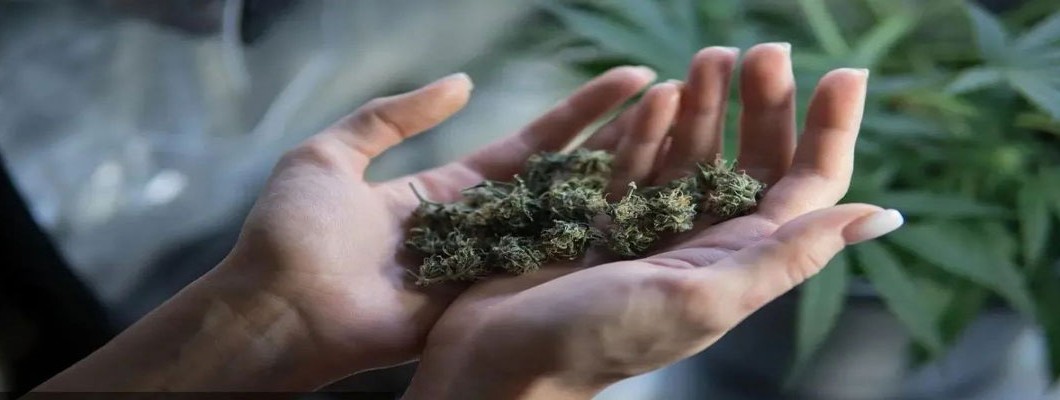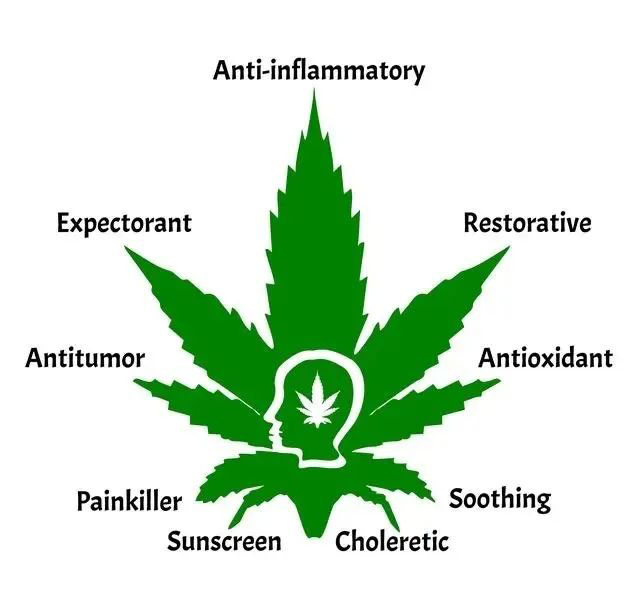
Menopause has always been under-appreciated in the medical community or only mentioned by faint voices and euphemisms, but now it is finally having its own high moment. Over the past few years, it seems that every female netizen between the ages of 45-55 has been speaking candidly about their own struggles with plummeting oestrogen levels, and many of them have highlighted how cannabidiol (CBD) and medical cannabis products have helped them alleviate their debilitating symptoms. In addition to these anecdotes, recent scientific data suggests that more and more women are using medical marijuana to alleviate symptoms such as anxiety, sleep disturbances and night sweats typical of menopause.
This is because during perimenopause, our estrogen levels fall apart, like an unwanted guest entering the body. Where once the body was healthy, emotionally stable, sleeping well and clear-headed, now there are rumbling anxieties, anger-filled emotions, abyssal depression, sweat-soaked sleep and a mind so muddled that even thinking becomes like wading through a river.
As a result of these disruptions and imbalances, it is not surprising that the endocannabinoid system (ECS), the body's primary homeostatic regulator, undergoes significant changes as women transition from childbearing to menopause. It is even thought that the ECS may play a role in heart disease, osteoporosis, and certain cancers, among other health problems commonly experienced by women after menopause.
From Peri-Menopause to Menopause
It is important to clarify that menopause is not a disease. It is a natural process that results in the gradual cessation of menstruation (the average age of menopause is 51 years) due to a decline in the levels of hormone production (mainly oestrogen and progesterone) in the ovaries. However, for many women, perimenopause, the transitional period when hormone levels begin to fluctuate, can actually be more challenging than menopause itself.
During perimenopause, our estrogen levels fall apart and it's like an uninvited guest enters the body.
Genester Wilson-King, M.D., who is the founder and certified obstetrician and gynecologist of Florida's Victory Revival and vice president of the Cannabis Physicians Association, explains, "Hormones can change in 24 hours or in a matter of months. So, it's a really tough time. The perimenopause is the most common time in a woman's life when suicide occurs. You don't know what you're going to do."
Most women benefit from the protection and mood elevation of normal oestrogen levels until the onset of perimenopause. However, when their oestrogen levels drop, some women who have never experienced low mood or anxiety may experience them for the first time; others with a history of mental illness may find that they experience a significant worsening of these symptoms.
For Julie Durrans of the UK, not only did her existing anxiety worsen during the perimenopause, but the hormonal changes also caused her overall health to deteriorate further. Referring to Ehlers Danlos Syndrome, which was diagnosed during menopause, she says: "As I entered menopause, my joints began to become inflamed and worse, and joint misalignments became more frequent. The migraines that struck three to four times a week were even more debilitating, and that's when my doctor thought I was at high risk of having a stroke."
During perimenopause, it is not uncommon for a sharp drop in oestrogen to cause a woman's already healthy condition to deteriorate and for new conditions such as fibromyalgia to develop.
Colleen Fisher Tully, a 44-year-old Canadian women's health writer, suddenly developed vulvar pain syndrome, a severe pain in the vulva, in addition to night sweats, sleep disturbances, and more frequent migraines two weeks before her period.
Colleen says, "They call it vulvar fibromyalgia, and it's just the scariest thing ever."
With these many uncomfortable symptoms, it's no surprise that women often have a low sex drive during the peri-menopausal and menopausal stages. Amidst the night sweats, insomnia, anxiety, migraines, heart palpitations and vaginal dryness, the pleasures of sex are not as appealing.

Estrogen and the endogenous cannabinoid system
If a patient is not a candidate for hormone therapy, or has some residual symptoms such as mild anxiety even after hormone therapy, Dr. Genest Wilson King will often recommend cannabis for her patients at her Florida clinic.
I've seen a lot of patients in hormone transition," she says. I've also seen cannabis be very, very helpful." However, Dr. King also points out that while only hormone therapy can truly promote balance during the perimenopausal/menopausal phase, we should not underestimate the role of the endocannabinoid system in women's hormonal health.
"I've seen a lot of patients in hormonal transition. I've also seen cannabis be very, very helpful." --Dr. Genest Wilson King
She explains, "The endogenous cannabinoid system is very active in the female reproductive tract. The human ovaries are capable of producing endogenous cannabinoids, so throughout a healthy woman's menstrual cycle, from the menstrual period to the follicular phase of ovulation, endogenous cannabinoid levels are high in the menstrual period and reach their highest during ovulation and lower during the luteal phase."
Echoing these fluctuations in endogenous cannabinoids, oestrogen is also highest before and during ovulation and decreases during the rest of the cycle month.
We usually think of the ECS as the master regulator, but when it comes to the female reproductive system, it's estrogen that seems to call the shots.
Estrogen regulates fatty acid amide hydrolase (FAAH), an enzyme that breaks down endogenous cannabinoids," says Wilson-King. Thus, when endogenous cannabinoid levels need to be raised, estrogen keeps levels of FAAH low, which raises endogenous cannabinoid levels."
What remains unclear is why high levels of endogenous cannabinoids need to be maintained prior to ovulation, but interestingly, as someone who struggles with premenstrual syndrome for much of my period, I find that my periods often coincide with the ebb and flow of feel-good endogenous cannabinoid levels.
Post-menopausal pathology
It is thought that the endocannabinoid system and its underlying dysregulation also play a role in the pathology that occurs in the years following menopause (when endocannabinoid levels are low).
Globally, 30% of women over the age of 50 suffer from osteoporosis, a condition in which bones become weaker and more brittle.CB2 receptors play a role in healthy bone formation, and in a mouse model of menopause, a reduction in oestrogen is associated with diminished CB2 expression. Conversely, the use of oestrogen inhibits the formation of osteoclasts (cells that break down bone tissue), a process regulated by CB2 activation.
In the 2021 paper 'The role of the endocannabinoid system in menopause and its associated diseases', Italian researchers suggest that the estrogen-dependent decline in endocannabinoid levels may explain, in part, why postmenopausal women are at higher risk of developing cancer (endocannabinoids are known to show anti-tumour activity).
Perhaps we should not take such a double whammy on women's health lightly when two key protective endocannabinoids begin to decline in women. It is perhaps no coincidence that at this age, some women develop diseases associated with clinical endocannabinoid deficiencies. On a more personal level, this may help explain why exercise and the associated boost in endocannabinoids always improved the pain and discomfort I had become accustomed to during the perimenopause.
Lack of interest from doctors
Both Julie Durrance and Colleen Fisher-Tully found medical cannabis very helpful in improving their perimenopause-related sleep disturbances, anxiety and migraines. For Colleen, THC suppositories in particular relieved her monthly vulvar pain syndrome. Interestingly, Colleen's experience is supported by a pre-clinical study which suggests that a reduction in THC-mediated mast cell accumulation may be responsible for reduced vulvar sensitivity.
In their respective countries, both Julie and Colleen were able to access cannabis through medical marijuana clinics for non-menopause-related conditions. Although they told their clinicians about their perimenopausal conditions, the doctors had little interest in documenting the improvement in their symptoms after using cannabis.
It was as if I hadn't said anything," recalls Colleen. I thought he would be interested because I knew that coping with menopausal and perimenopausal symptoms was one of the best uses of medical cannabis. There wasn't a lot of clinical evidence, but anecdotal evidence was overwhelming. I thought to myself, 'Wow, you missed an opportunity to follow up and not ask me what would be useful and add this data to your clinical record.'"
Those who don't bother to ignore the rules are often women's health-focused doctors like Dr. Kim, who combine hormone balancing techniques with cannabis. For Dr. Kim, it's a win-win situation.
She bitterly told the CBD Project, "I always say that a woman who uses medical cannabis for hormone balancing can be a whole new woman." Perhaps she was referring to the effects she sees in her patients, those with low libido and suffering from sexual dysfunction, who reap the benefits of self-care with medical cannabis.
What is the evidence?
Although studies have shown CBD and medical marijuana to be effective in improving key symptoms of menopause, such as anxiety and sleep disturbances, there is little data on menopause and no clinical trials.
In a June 2022 preclinical study, scientists at Rutgers University in New Jersey claimed that CBD had a protective effect on the health of postmenopausal mice. Mice that consumed CBD-coated peanut butter balls had healthier bones, better intestinal bacterial flora, and burned more energy than mice in the non-CBD group. As hormone replacement therapy is not suitable for women over the age of 60, special attention should be paid to the fact that other options are needed. Further research is necessary to see if pre-clinical evidence of CBD for post-menopausal conditions such as osteoporosis can be transferred to humans in the clinic.
A recently published self-reported survey with 258 participants provides a snapshot of how women use medical cannabis to manage their symptoms. The survey found that 67.4% of women surveyed used medical marijuana for sleep assistance, 46.1% for anxiety relief and 30.4% for libido enhancement. In addition, 51% of women would mix recreational and medical cannabis, with 30.8% using recreational cannabis only and 17.7% using medical cannabis only. The most common form of use was smoking, at 84.3%, including roll-ups, pipes, and hookahs, followed by consumption, at 78.3%, of which 52.6% used oils, perhaps reflecting the blurring of the line between recreational and medical use.
But the survey did not indicate the efficacy of medical marijuana products for menopause-related symptoms or the types of medical marijuana chemicals used by participants, and the authors called for future longitudinal observational studies and clinical trials with baseline assessments before starting medical marijuana use.
A previous Midlife Women Veterans Health Survey interviewed 232 women in Northern California with an average age of 59.5 years and found that approximately one in four had used medical marijuana to cope with menopause-related symptoms. But again, this survey lacked data showing the success of medical marijuana in improving these symptoms.
It seems that, just as in society at large, women are often left to fend for themselves during the challenging menopause transition, those who choose to use medical cannabis and CBD are relying on a "whisper network" of their female friends, family and colleagues, or just plain trial and error to find what works best for them.
At the very least, when perimenopausal/menopausal women become patients at medical cannabis clinics, their hormonal status should be acknowledged and documented, including how it affects their overall health and how medical cannabis can help them cope with menopause-related symptoms.

Leave a Comment